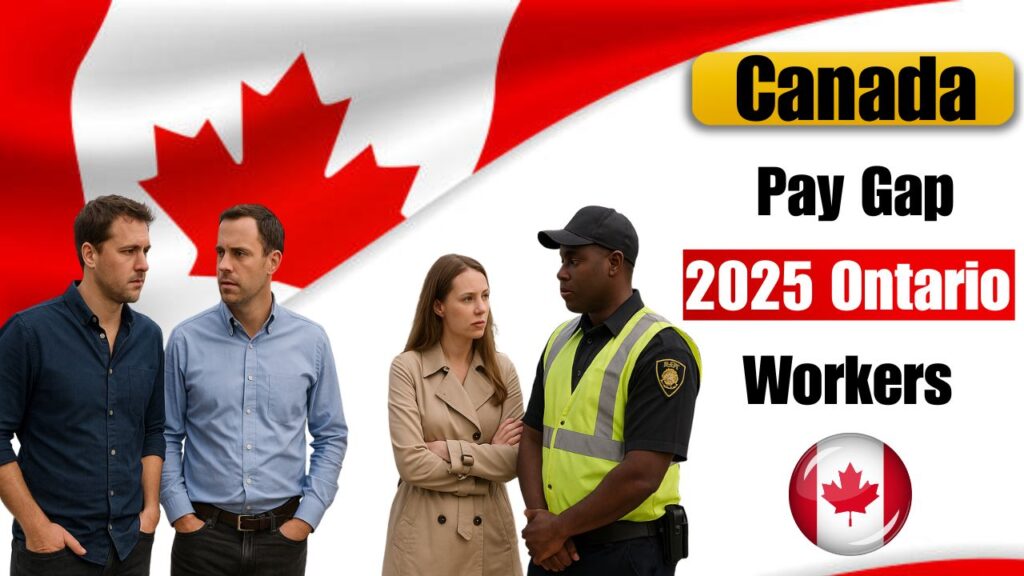Canada Pay Gap 2025 – The widening pay gap in Canada has become a major topic in 2025, especially across Ontario. Recent data reveals that government employees are now earning significantly more than their private sector counterparts. This trend highlights growing concerns about wage disparity, job stability, and pension benefits between public and private sector workers. As the Canadian job market evolves, the pay imbalance has sparked debates about fairness, taxation, and sustainability of government wages. Let’s take a closer look at why public sector workers are earning more and what this means for Ontario’s workforce.

Public Sector Pay Rise in Canada 2025
In 2025, many Canadian government employees experienced a noticeable increase in their salaries compared to those in private companies. Data from Ontario’s Ministry of Labour shows that public sector workers now earn, on average, 10–15% more than private sector employees with similar roles. Factors contributing to this include union negotiations, inflation adjustments, and improved benefit packages. Government jobs also offer stronger pension plans and healthcare coverage, which further boost total compensation. This pay rise has become a point of contention among private workers who face stagnant wages and fewer benefits amid economic challenges in Canada.
 $1,433 Canada Pension Plan 2025 — CRA Confirms New Payment Dates and Eligibility for Ontario Seniors
$1,433 Canada Pension Plan 2025 — CRA Confirms New Payment Dates and Eligibility for Ontario Seniors
Ontario Government Wage Gap Compared to Private Sector
The Ontario government has justified higher salaries as a measure to retain skilled professionals and reduce turnover rates in critical sectors such as healthcare, education, and administration. However, reports suggest that the Ontario wage gap between public and private employees has now reached record levels. Private companies continue to struggle with wage competitiveness due to higher operating costs and inflation pressures. Moreover, public employees enjoy additional job security, which adds to the overall value of their compensation. Analysts argue that this widening gap may discourage private sector participation in key industries, especially among young professionals.
| Sector | Average Annual Salary (2025) | Increase from 2024 | Benefits Coverage |
|---|---|---|---|
| Federal Government | CAD 92,800 | +7.5% | Comprehensive (Pension + Health) |
| Provincial Government (Ontario) | CAD 88,400 | +6.8% | Full Coverage |
| Private Sector | CAD 76,300 | +3.2% | Limited (Health Only) |
| Education Sector | CAD 85,600 | +5.9% | Full Coverage |
| Healthcare Workers (Public) | CAD 90,200 | +6.5% | Pension + Health |
Canadian Workforce Pay Disparity and Long-Term Impacts
Experts believe that the growing wage disparity in the Canadian workforce may lead to long-term structural challenges. Private employers could face recruitment difficulties as more skilled workers shift towards government roles offering better pay and job stability. Economists warn that this imbalance may also burden taxpayers, as higher government wages are funded through public expenditure. While the government defends the hikes as necessary for competitiveness, critics argue that such practices could deepen inequality and widen the divide between public and private employment opportunities across Canada in 2025 and beyond.
Economic Implications of Pay Gap for Canadians
The expanding pay gap is influencing overall economic balance across Canada. With government employees earning more disposable income, local spending may increase, benefiting retail and service industries. However, stagnant private sector wages could lead to reduced consumer confidence and slower economic recovery. Policymakers must find a sustainable solution that supports fair compensation while maintaining economic equilibrium. For now, Canadians are divided on whether government salaries should continue to outpace private earnings or if reforms are needed to ensure a more equitable system in the near future.
Frequently Asked Questions (FAQs)
1. Why are government workers in Ontario earning more?
Government salaries increased due to union agreements, inflation adjustments, and better benefit structures.
2. How much higher are public sector wages compared to private?
On average, public employees earn about 10–15% more than private sector workers in Ontario.
3. Does the pay gap affect taxpayers?
Yes, higher government wages may increase public spending funded by taxpayers over time.
 Public Pensions Canada 2025 — CPP $1,433, OAS $765 & GIS $1,080 Increases Confirmed for Seniors
Public Pensions Canada 2025 — CPP $1,433, OAS $765 & GIS $1,080 Increases Confirmed for Seniors
4. What is being done to reduce the pay disparity?
Policymakers are reviewing compensation policies and promoting wage growth in the private sector.


